Clematis Sunset - planting and grooming tips
The perennial, brightly blooming Sunset Clematis belongs to the liana-like varieties. The originator of the culture is Arthur Steffan from New York. He developed this variety in 1990. Consider the main characteristics of the plant, the rules of planting, care and methods of reproduction.
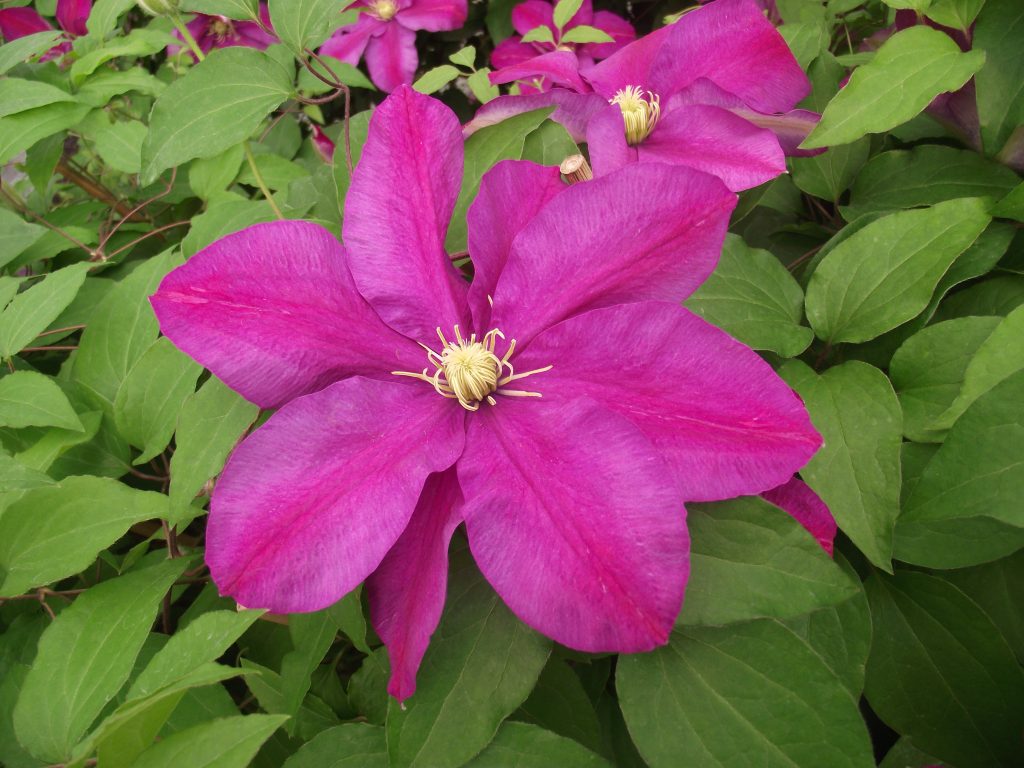
Clematis Sunset Description
Description of the plant
The botanical name is clematis sunset. The description of a perennial large-flowered liana includes several distinctive qualities:
- in warm climatic conditions, climbing shoots reach 3 m, in cold climates - 1.5-2 m;
- the stems are flexible, massive, densely covered with small emerald leaves;
- flowers are bright pink and large (up to 15 cm in diameter), petals are elongated, pointed, stamens of golden tone.
Flowers are formed at the tips of last year's shoots. This variety is excellent for vertical gardening. Also used to decorate horizontal surfaces.
In Russia, this decorative culture is grown everywhere, because it has a high decorative effect, disease resistance and relatively good frost resistance.
Landing features
The planting time of young bushes depends on their condition - if they were purchased in a pot, then they can be planted throughout the entire growing season. Clematis, acquired with an open root system, are planted in the spring before the vegetative buds begin to swell.

Sunset clematis photo
Preparation of seedlings
If you want a strong plant with all the varietal traits, go to a florist's nursery to buy. Clematis 2-3 years old is considered the best material. It has a well-branched root system and crown.
It is better to choose seedlings with closed roots - in an earthen coma or container. Their survival rate is almost 100%.
Buy fresh bushes with juicy leaves and shoots, without mechanical injuries and signs of disease.
If the roots of clematis are dry, then before planting, they must be immersed in warm water (40 ° C) with the addition of Kornevin or Heteroauxin. The exposure time is 2 hours.
Site and soil preparation
Prefers to grow in a sunny place where there is no draft. Under the influence of strong winds, there is a high risk of breaking off the shoots. If you are going to plant near the walls of a house or outbuilding, you need to make an indent of 0.5 m. So the water flowing from the roof will not flood the bush.
Clematis loves light, well-drained soil with neutral acidity. If the ground is acidic, it will stop growing and bloom sparsely. The optimal level is 6 units. If it exceeds the norm, you need to add dolomite flour, slaked lime or chalk - 200 g per 1 m².
Also, the plant does not like swamps - the groundwater should lie at 3-4 m. Otherwise, the roots will quickly rot and the plant will die.
When grown on clay and depleted soil, a composition of compost, sand and peat (1: 1: 1) is added to the planting pit. In addition to this mixture, 250 g of wood ash, 100 g of complex mineral fertilizers are mixed.
Landing technology
Consists of several stages:
- dig holes measuring 70x80 cm;
- a little drainage from pebbles, crushed stone, brick chips and screenings is laid on the bottom;
- fill the hole with a nutrient mixture, ram it;
- make a small depression, remove a seedling from the pot, lower it together with a lump of earth into a hole;
- all voids are covered with soil, trampled in the near-trunk zone, watered;
- a peg is driven in next to the plant for support, tied with twine;
- to avoid drying out the soil, mulch with peat or last year's manure.
It is necessary to plant so that the root collar remains 4-5 cm above the soil surface. This will prevent its decay and death of the entire plant.
When growing in groups, it is necessary to maintain a distance: between seedlings - 2-2.5 m, in a row - 2 m.
In the first month, clematis, which does not tolerate direct sunlight, will need shading. Burlap or agrofibre is pulled over the flower bed. The second option is to plant bushes between other vegetation - marigolds, calendula.
Care
The main care of this flower does not present any particular difficulties and costs, so even a beginner florist can grow it.
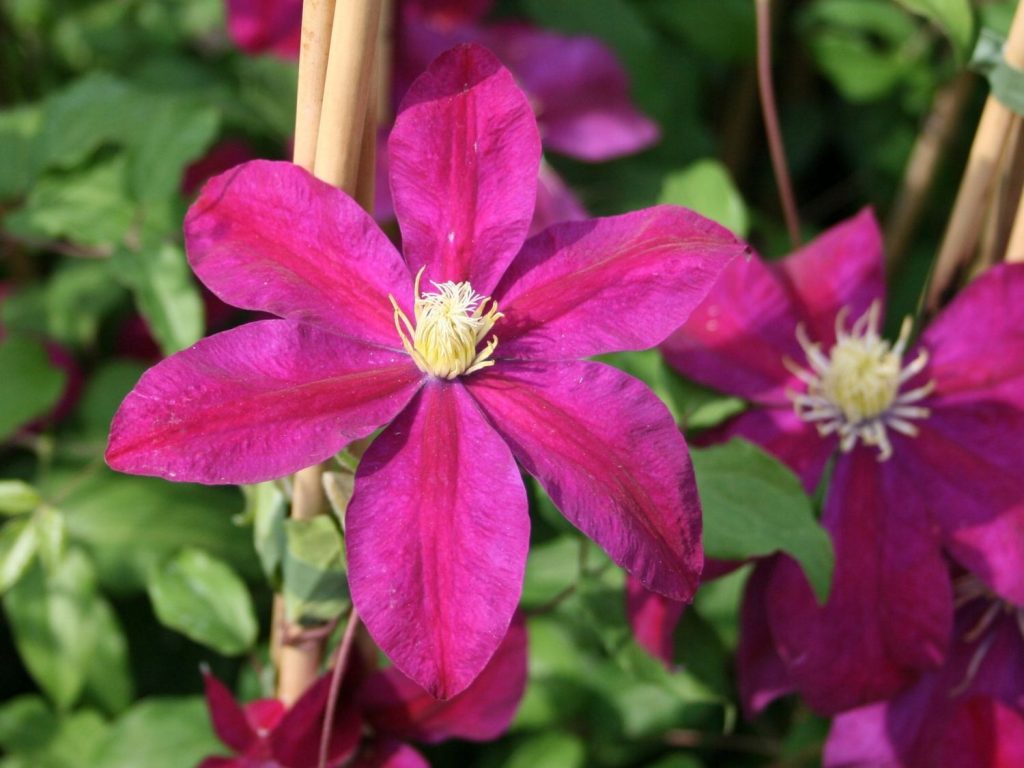
Clematis Sunset Photo
Watering
This ornamental crop loves slightly moist soil, so watering should be regular and moderate. In extreme heat and drought, moisten every three days. They pour so much water that the earth dries out to a depth of 30 cm. For young specimens, 10 liters are enough, for adults - 25-30 liters. Use warm and settled water.
Reacts positively to periodic sprinkling of the crown. This stimulates the development of new shoots and leaves. Washing also maintains decorativeness and prevents the appearance of parasites.
Watering and spraying is carried out in the evening, when the sun goes down, so that the leaves are not burnt.
After each moistening, it is necessary to carry out surface loosening of the soil. It helps maintain moisture and breathability. Together with this procedure, the aisles are weeded, unnecessary vegetation is removed.
To retain moisture, the trunk circle is mulched with a thick layer of peat. Mulch also provides additional root nutrition and prevents weed growth.
Top dressing
It is difficult to achieve a lush and long-lasting flowering of sunset clematis on depleted land, so growers periodically feed it:
- at the beginning of spring, nitrogen-containing preparations are introduced, which stimulate the intensive growth of green mass and roots;
- in the budding phase - superphosphate;
- immediately after the end of flowering - potassium sulfate;
- 15 days before the onset of the first frost, they are fed with a complex mineral composition.
During fertilization, the dosage should be strictly adhered to, since overfed clematis do not grow well and may not bloom.
Nutrition at the root is combined with watering to accelerate the absorption of nutrients.
During the flowering phase, the liana cannot be fertilized, since this can negatively affect the quality and duration of the process.
Pruning
This plant belongs to the second pruning group - it is trimmed twice a year. The first haircut is carried out at the end of June, when it has completely faded. All stems of the last year are shortened by ½ the length.
The second time in the fall - 4 weeks before the upcoming frost. The branches of the current season are pruned, leaving 2-4 of the most developed buds. Weak, thin, mechanically damaged or diseased shoots are cut into a ring.
To avoid infection, a sharp and well-sharpened secateurs are used for this procedure. After it is carried out, it is irrigated with a solution of copper sulfate.
Preparing for winter
The variety is frost-resistant - clematis in adulthood can safely overwinter without insulation.
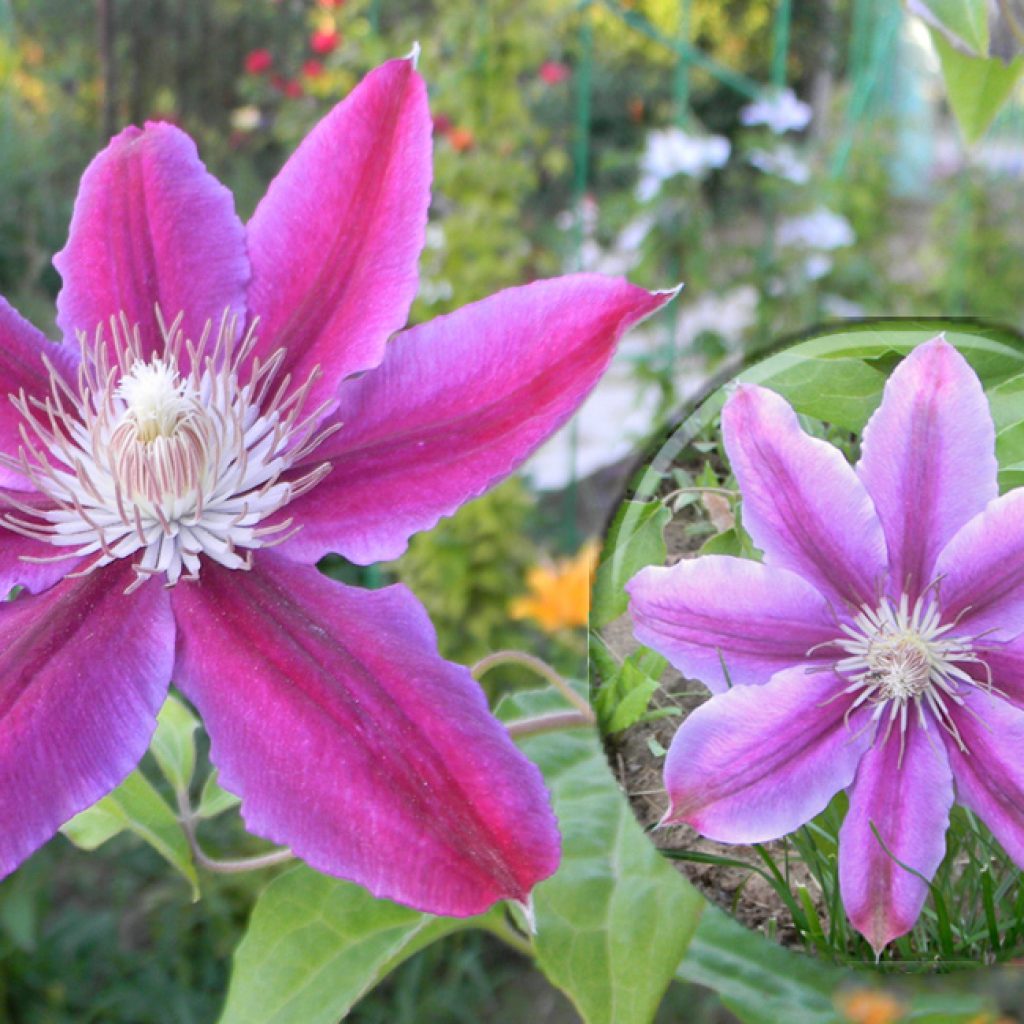
Clematis Sunset Reviews
Shelter is necessary for young plantations up to three years old. They are prepared two weeks before the onset of persistent cold weather:
- first moisten abundantly with warm water (40 ° C);
- then fertilized with phosphorus-potassium dressing;
- spud the near-trunk zone with a mixture of sand and peat, forming a hill 15 cm high;
- as soon as the temperature drops to -3 ° C, the branches are bent to the ground, fixed with brackets, sprinkled with fallen leaves or spruce branches, a wooden box or cardboard box is placed on top.
Reproduction methods
There are two effective breeding methods for this vine, which gardeners have been successfully using for more than a year.
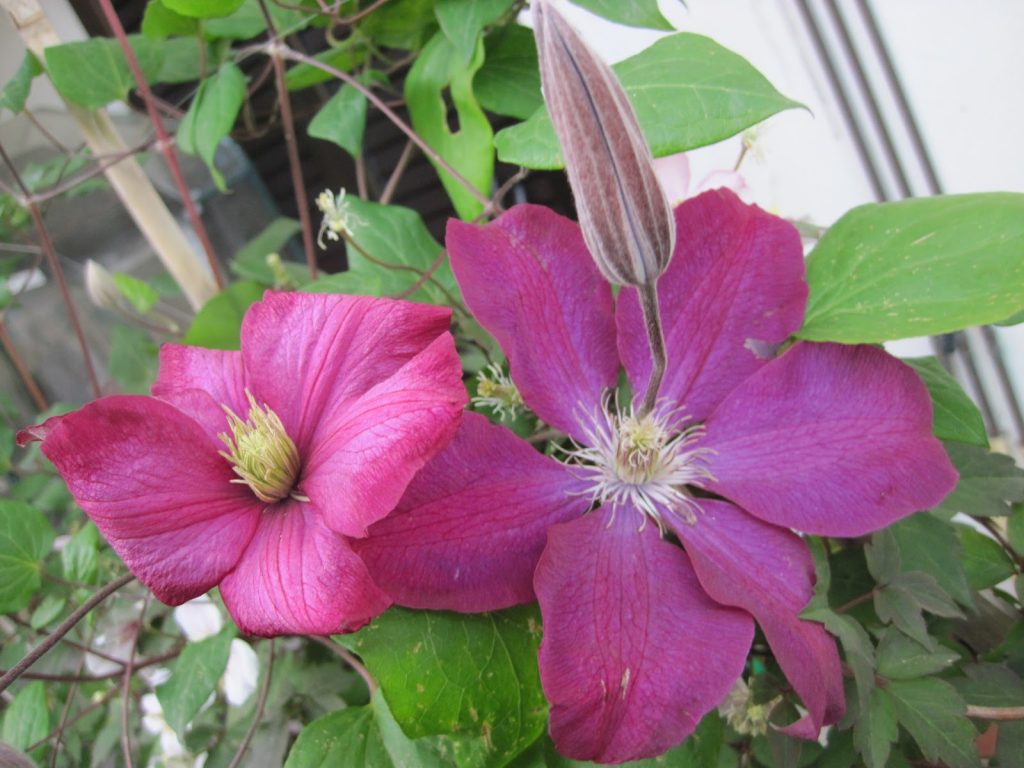
Clematis Sunset
Cuttings
Shoots 7-8 cm long are cut from a healthy and adult plant in the fall. Each cutting should have 2-3 well-developed eyes. For quick rooting, the workpieces are dipped into one of the growth stimulants for half an hour. Then they are planted in a mixture of peat and sand to a depth of 4 cm at a slight slope.
The plantings are transferred to a cool room, where the temperature is about 0 ° C and there is no direct sunlight.
With the arrival of spring, the seedlings are moved into heat and set in the light with protection from the scorching sun. To stimulate the growth of roots, all the leaves in the lower part are cut off. Transplanting into open ground is carried out after 2-3 months of home growing.
Stem layering
This is the safest and easiest way to breed new seedlings. On an adult liana, a strong and long shoot is chosen, which is closest to the ground.
Remove all the leaves on it, put them in a dug trench to a depth of 5 cm. For fixation, take staples. The tip of the stem should be above the ground.
From above, the branch is covered with a mixture of peat and sand, moistened. Before the onset of persistent cold weather, sprinkle with a thick layer of sawdust, peat, humus or fallen leaves. This will protect the layers from freezing in winter.
As soon as spring comes, the snow thaws and the heat of the street stabilizes, the branch is dug up, cut off from the mother bush. Divided into several parts with roots, seated separately in the garden.
Diseases and pests
Clematis Sunset has good disease and pest resistance. Infection occurs only if the rules of landing and leaving are violated:
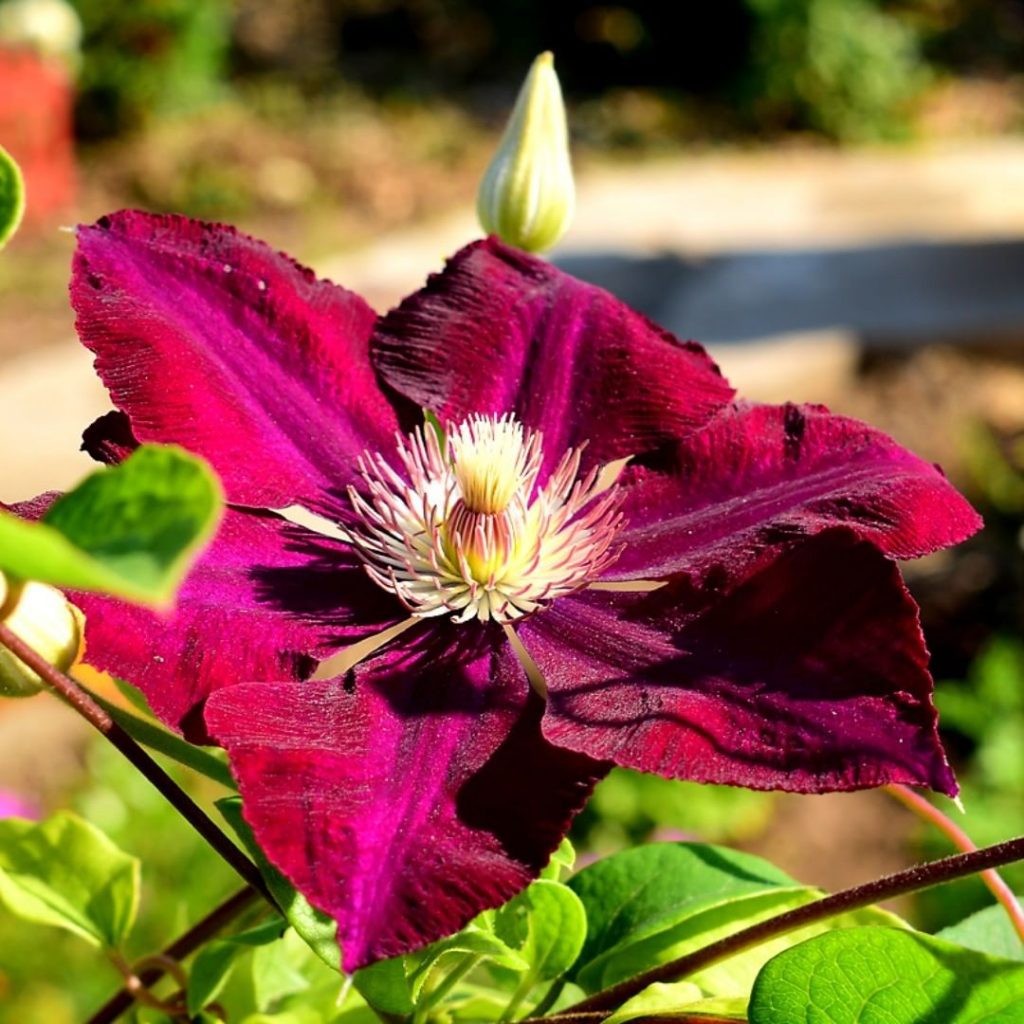
Clematis variety Sunset
- Wilt Wilt. Signs - withered foliage at the tops of the stems. If you do not take the necessary measures in time, the vine will quickly die. If a sore is found, it is necessary to cut off all the shoots to the base. Then spill the root system with a strong solution of potassium permanganate.
- Leaf necrosis. This is a fungal infection that appears as dark brown spots on the foliage surface. Infected places die off, dry out, crumble. You can save the plant if you remove all damaged areas, then irrigate the crown with a solution of copper sulfate of 1% concentration.
- Rust. Signs of damage are reddish lumpy growths on the outside of the leaves. If left untreated, the creeper begins a massive leaf fall, the twigs are deformed. You can destroy a fungal infection if you remove all infected areas and treat the crown with a fungicide - Ridomil Gold, Skor or Hom.
- Nematode. This insect damages the root system, blocks access to oxygen, moisture and nutrients. Such a plant cannot be treated, therefore clematis is dug up and disposed of. The place of growth is spilled with a solution of copper sulfate or potassium permanganate.
For prevention, you need to buy healthy seedlings. Before planting them, dig up the site, add all the nutritional components. It is also important to adhere to the planting scheme in order to prevent thickening. Regular loosening, removal of weeds, pruning of non-viable parts are additional measures that will help prevent the appearance of diseases and pests.
Application in landscape
The perennial vine has gained great popularity in modern garden design:
- long, flowering lashes beautifully decorate arches, gazebos, an area near the terraces;
- in group cultivation, clematis is planted along fences, near the walls of a house or other buildings;
- combined with other liana-like varieties, which allows you to create a multi-colored composition on your personal plot;
- some are used as a ground cover for landscaping inconspicuous and gloomy places in the garden.
Variety reviews
Many gardeners have the Sunset variety in good standing and is valued for its unique qualities:

Clematis Sunset landing and care
- has good frost resistance and immunity against diseases, therefore it is grown everywhere;
- thanks to the long lashes that create a dense crown, it is possible to plant greenery on any area and surface in the garden using a support;
- long and bright blooms, so it can be an excellent addition to decorative deciduous perennials.

